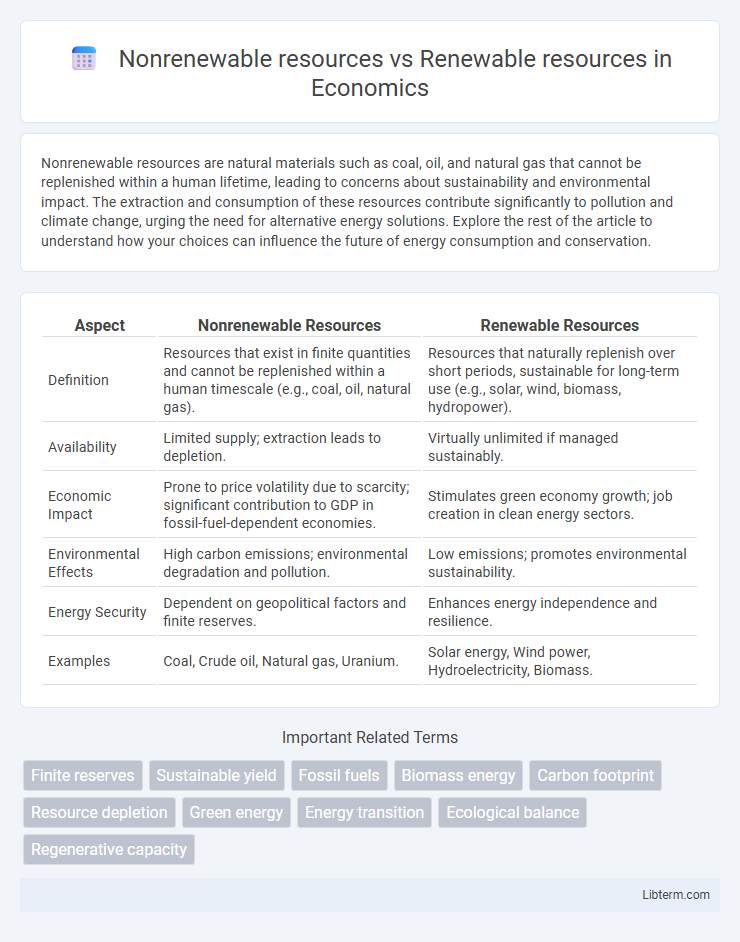Nonrenewable resources are natural materials such as coal, oil, and natural gas that cannot be replenished within a human lifetime, leading to concerns about sustainability and environmental impact. The extraction and consumption of these resources contribute significantly to pollution and climate change, urging the need for alternative energy solutions. Explore the rest of the article to understand how your choices can influence the future of energy consumption and conservation.
Table of Comparison
| Aspect | Nonrenewable Resources | Renewable Resources |
|---|---|---|
| Definition | Resources that exist in finite quantities and cannot be replenished within a human timescale (e.g., coal, oil, natural gas). | Resources that naturally replenish over short periods, sustainable for long-term use (e.g., solar, wind, biomass, hydropower). |
| Availability | Limited supply; extraction leads to depletion. | Virtually unlimited if managed sustainably. |
| Economic Impact | Prone to price volatility due to scarcity; significant contribution to GDP in fossil-fuel-dependent economies. | Stimulates green economy growth; job creation in clean energy sectors. |
| Environmental Effects | High carbon emissions; environmental degradation and pollution. | Low emissions; promotes environmental sustainability. |
| Energy Security | Dependent on geopolitical factors and finite reserves. | Enhances energy independence and resilience. |
| Examples | Coal, Crude oil, Natural gas, Uranium. | Solar energy, Wind power, Hydroelectricity, Biomass. |
Understanding Nonrenewable and Renewable Resources
Nonrenewable resources such as coal, oil, and natural gas have finite supplies and form over millions of years, making their depletion a critical environmental concern. Renewable resources, including solar energy, wind power, and biomass, are replenished naturally and provide sustainable alternatives for energy production. Understanding the differences between these resources is essential for developing efficient energy policies and promoting environmental sustainability.
Key Differences Between Nonrenewable and Renewable Resources
Nonrenewable resources, such as coal, oil, and natural gas, are finite and take millions of years to form, leading to depletion as they are consumed. Renewable resources, including solar, wind, and biomass, regenerate naturally on a human timescale, providing sustainable energy alternatives. Key differences center on availability duration, environmental impact, and sustainability, with renewable resources offering lower emissions and long-term supply stability.
Examples of Nonrenewable Resources
Nonrenewable resources include fossil fuels such as coal, oil, and natural gas, which are formed over millions of years and cannot be replenished within a human lifespan. Minerals like gold, silver, and uranium are also classified as nonrenewable due to their finite availability and slow natural formation processes. These resources contrast with renewable resources like solar energy and wind power, which are naturally replenished on a human timescale.
Common Types of Renewable Resources
Solar energy, wind energy, hydroelectric power, biomass, and geothermal energy are common types of renewable resources that provide sustainable alternatives to nonrenewable resources such as coal, oil, and natural gas. Renewable resources regenerate naturally over short periods, reducing environmental impact and decreasing reliance on finite fossil fuels. The increased utilization of renewable resources supports energy security and mitigates climate change effects by lowering greenhouse gas emissions.
Environmental Impact: Nonrenewable vs Renewable
Nonrenewable resources such as coal, oil, and natural gas contribute significantly to greenhouse gas emissions, air pollution, and environmental degradation due to their extraction and combustion processes. Renewable resources like solar, wind, and hydroelectric power generate energy with minimal carbon footprints, reducing the risk of climate change and habitat destruction. Transitioning to renewable energy sources is essential for sustainable development and mitigating adverse environmental impacts associated with nonrenewable resource use.
Economic Factors and Cost Analysis
Nonrenewable resources such as coal, oil, and natural gas often have lower upfront extraction costs but face increasing expenses due to depletion and environmental regulations, impacting long-term economic sustainability. Renewable resources like solar, wind, and hydro power require significant initial capital investment but benefit from declining costs driven by technological advancements and zero fuel expenses, leading to competitive levelized costs of energy (LCOE) over time. Evaluating economic factors involves comparing externalities, subsidies, and lifecycle costs, highlighting renewables' growing advantage in reducing operational expenditures and mitigating market volatility associated with fossil fuels.
Energy Production and Efficiency
Nonrenewable resources, such as coal, oil, and natural gas, dominate traditional energy production due to their high energy density but face limitations like finite supply and environmental impact. Renewable resources, including solar, wind, and hydroelectric power, provide sustainable energy with lower emissions and decreasing costs, enhancing long-term energy efficiency and grid stability. Advances in energy storage and smart grid technologies improve the integration and reliability of renewable resources, making them increasingly competitive with nonrenewable sources.
Resource Availability and Sustainability
Nonrenewable resources, such as coal, oil, and natural gas, have finite reserves that diminish with extraction, leading to eventual depletion and environmental degradation. Renewable resources, including solar, wind, and biomass, offer sustainable energy generation by naturally replenishing over short periods, promoting long-term availability and reduced ecological impact. Prioritizing renewable resources enhances sustainability through consistent resource availability without exhausting Earth's finite reserves.
Future Trends in Resource Utilization
Future trends in resource utilization indicate a significant shift from nonrenewable resources such as coal, oil, and natural gas toward renewable resources including solar, wind, and bioenergy due to environmental concerns and technological advancements. Investment in smart grid technologies and energy storage solutions enhances the efficiency and reliability of renewable energy integration, promoting sustainable consumption patterns. Policies incentivizing carbon reduction and innovation in materials science further drive the transition toward circular economies and reduced dependency on finite nonrenewable resources.
Transitioning Toward Renewable Energy Solutions
Transitioning from nonrenewable resources such as coal, oil, and natural gas to renewable energy solutions like solar, wind, and hydroelectric power significantly reduces greenhouse gas emissions and mitigates climate change. Investments in renewable energy technologies drive advancements in energy storage, grid integration, and cost reduction, facilitating a sustainable energy future. Governments and industries worldwide are implementing policies and incentives to accelerate the adoption of renewables and phase out fossil fuel dependence for cleaner, more resilient energy systems.
Nonrenewable resources Infographic

 libterm.com
libterm.com